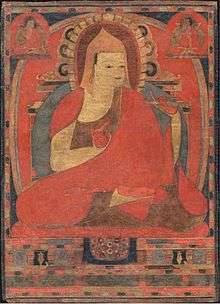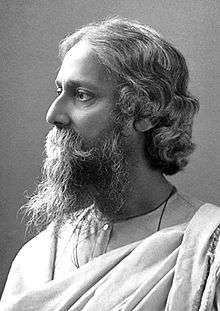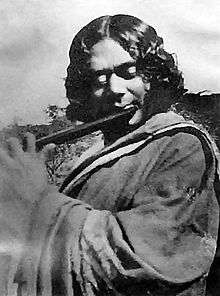History of Bangladesh
Part of a series on the |
|---|
| History of Bangladesh |
.jpg) |
|
Ancient
|
|
Classical
|
|
Medieval
|
|
Modern
|
|
Related articles |
| Part of a series on the |
| Culture of Bangladesh |
|---|
|
Rice Bread Fish Sweets Snacks Sauce |
| Religion |
|
Architects Painters Sculptor |
|
Literature History Genres Institutions Awards Writers |
|
Music and performing arts |
|
Monuments |
|
Modern Bangladesh emerged as an independent nation in 1971 after breaking away and achieving independence from Pakistan in the Bangladesh liberation war. The country's borders coincide with the major portion of the ancient and historic region of Bengal in the eastern part of the Indian subcontinent, where civilization dates back over four millennia, to the Chalcolithic. The history of the region is closely intertwined with the history of Bengal and the history of India.
The area's early history featured a succession of Indian empires, internal squabbling, and a tussle between Hinduism and Buddhism for dominance. Islam became dominant gradually since the 13th century when Sunni missionaries arrived. Later, Muslim rulers reinforced the process of conversion by building masjid (mosques) and madrassas.
The borders of modern Bangladesh were established with the partition of Bengal and India in August 1947, when the region became East Pakistan as a part of the newly formed State of Pakistan following the Radcliffe Line.[1] However, it was separated from West Pakistan by 1,600 km (994 mi) of Indian territory. Due to political exclusion, ethnic and linguistic discrimination, as well as economic neglect by the politically dominant western-wing, popular agitation and civil disobedience led to the war of independence in 1971. After independence, the new state endured famine, natural disasters and widespread poverty, as well as political turmoil and military coups. The restoration of democracy in 1991 has been followed by relative calm and economic progress.
Etymology of Bengal
The exact origin of the word Bangla or Bengal is unknown. According to Mahabharata, Purana, Harivamsha Vanga was one of the adopted sons of King Vali who founded the Vanga Kingdom.[2] The earliest reference to "Vangala" (Bôngal) has been traced in the Nesari plates (805 AD) of the south Indian ruler Rashtrakuta Govinda III, who invaded northern India in the 9th century,[3] which speak of Dharmapala as the king of Vangala. The records of Rajendra Chola I of the Chola dynasty, who invaded Bengal in the 11th century, speak of Govindachandra as the ruler of Vangaladesa.[4][5][6] Shams-ud-din Ilyas Shah took the title "Shah-e-Bangalah" and united the whole region under one government for the first time.[7]
The Vanga Kingdom (also known as Banga) was located in the eastern part of the Indian Subcontinent, comprising part of West Bengal, India and present-day modern Bangladesh. Vanga and Pundra were two dominant tribes in Bangladesh in ancient time.
Ancient period
Pre-historic Bengal

Many of archeological excavations in Bangladesh revealed evidences of the Northern Black Polished Ware culture (abbreviated NBPW or NBP) of the Indian Subcontinent (c. 700–200 BC) which was an Iron Age culture developed beginning around 700 BC and peaked from c. 500–300 BC, coinciding with the emerging of 16 great states or mahajanapadas in Northern India, and the subsequent rise of the Mauryan Empire.[8][9] The eastern part of ancient India, covering much of current days Bangladesh was part of one of such mahajanapadas, the ancient kingdom of Anga,[10] which flourished in the 6th century BCE.[11]
Linguistically, the oldest population of this land may have been speakers of Dravidian languages, such as the Kurux, or perhaps of Austroasiatic languages such as the Santals. Subsequently, people speaking languages from other language families, such as Tibeto-Burman, settled in Bengal. Indic Bengali represents the latest settlement.
While western Bangladesh, as part of Magadha, became part of the Indo-Aryan civilization by the 7th century BCE, the Nanda Dynasty was the first historical state to unify all of Bangladesh under Indo-Aryan rule. Later after the rise of Buddhism many missionaries settled in the land to spread the religion and established many monuments such as Mahasthangarh.
Overseas Colonization
The Vanga Kingdom was a powerful seafaring nation of Ancient India. They had overseas trade relations with Java, Sumatra and Siam (modern day Thailand). According to Mahavamsa, the Vanga prince Vijaya Singha conquered Lanka (modern day Sri Lanka) in 544 BC and gave the name "Sinhala" to the country. Bengali people migrated to the Maritime Southeast Asia and Siam (in modern Thailand), establishing their own colonies there.[7]
Gangaridai Empire

Though north and west Bengal were part of the empire southern Bengal thrived and became powerful with her overseas trades. In 326 BCE, with the invasion of Alexander the Great the region again came to prominence. The Greek and Latin historians suggested that Alexander the Great withdrew from India anticipating the valiant counterattack of the mighty Gangaridai empire that was located in the Bengal region. Alexander, after the meeting with his officer, Coenus, was convinced that it was better to return. Diodorus Siculus mentions Gangaridai to be the most powerful empire in India whose king possessed an army of 20,000 horses, 200,000 infantry, 2,000 chariots and 4,000 elephants trained and equipped for war. The allied forces of Gangaridai Empire and Nanda Empire (Prasii) were preparing a massive counterattack against the forces of Alexander on the banks of Ganges. Gangaridai, according to the Greek accounts, kept on flourishing at least up to the 1st century AD.
Early Middle Ages
The pre-Gupta period of Bengal is shrouded with obscurity. Before its conquest by Samudragupta, Bengal was divided into two kingdoms: Pushkarana and Samatata. Chandragupta II had defeated a confederacy of Vanga kings resulting in Bengal becoming part of the Gupta Empire.
Gauda Kingdom
By the 6th century, the Gupta Empire, which ruled over the northern Indian subcontinent had largely broken up. Eastern Bengal splintered into the kingdoms of Vanga, Samatata and Harikela while the Gauda kings rose in the west with their capital at Karnasuvarna (near modern Murshidabad). Shashanka, a vassal of the last Gupta Emperor proclaimed independence and unified the smaller principalities of Bengal (Gaur, Vanga, Samatata). He vied for regional power with Harshavardhana in northern India after treacherously murdering Harsha's elder brother Rajyavardhana. Harsha's continuous pressure led to the gradual weakening of the Gauda kingdom founded by Shashanka and finally ended with his death. This burst of Bengali power ended with the overthrow of Manava (his son), Bengal descended into a period marked by disunity and intrude once more.
The Pala dynasty
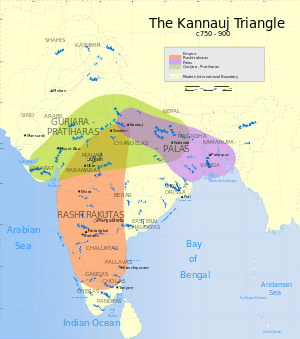
Pala dynasty were the first independent Buddhist dynasty of Bengal. The name Pala (Bengali: পাল pal) means protector and was used as an ending to the names of all Pala monarchs. The Palas were followers of the Mahayana and Tantric schools of Buddhism. Gopala was the first ruler from the dynasty. He came to power in 750 in Gaur, after being elected by a group of feudal chiefs.[12][13] He reigned from 750 to 770 and consolidated his position by extending his control over all of Bengal. The Buddhist dynasty lasted for four centuries (750-1120) and ushered in a period of stability and prosperity in Bengal. They created many temples and works of art as well as supported the Universities of Nalanda and Vikramashila. Somapura Mahavihara built by Dharmapala is the greatest Buddhist Vihara in the Indian Subcontinent.
The empire reached its peak under Dharmapala and Devapala. Dharmapala extended the empire into the northern parts of the Indian Subcontinent. This triggered once more for the control of the subcontinent. Devapala, successor of Dharmapala, expanded the empire considerably. The Pala inscriptions credit him with extensive conquests in hyperbolic language. The Badal pillar inscription of his successor Narayana Pala states that he became the suzerain monarch or Chakravarti of the whole tract of Northern India bounded by the Vindhyas and the Himalayas. It also states that his empire extended up to the two oceans (presumably the Arabian Sea and the Bay of Bengal). It also claims that Devpala defeated Utkala (present-day Orissa), the Hunas, the Dravidas, the Kamarupa (present-day Assam), the Kambojas and the Gurjaras.[14] These claims about Devapala's victories are exaggerated, but cannot be dismissed entirely: there is no reason to doubt his conquest of Utkala and Kamarupa. Besides, the neighbouring kingdoms of Rashtrakutas and the Gurjara-Pratiharas were weak at the time, which might have helped him extend his empire.[15] Devapala is also believed to have led an army up to the Indus river in Punjab.[14]
The death of Devapala ended the period of ascendancy of the Pala Empire and several independent dynasties and kingdoms emerged during this time. However, Mahipala rejuvenated the reign of the Pala. He recovered control over all of Bengal and expanded the empire. He survived the invasions of Rajendra Chola of the Chola dynasty and the Western Chalukya Empire from southern India. After Mahipala, the Pala dynasty again went into decline until Ramapala, the last great ruler of the dynasty, managed to retrieve the position of the dynasty to some extent. He crushed the Varendra Rebellion and extended his empire farther to Kamarupa, Odisha and northern India.
The Pala Empire can be considered as the golden era of Bengal. Never had the Bengali people reached such heights of power and glory. The Pala were responsible for the introduction of Mahayana Buddhism in Tibet, Bhutan and Myanmar. The Pala had extensive trade as well as influence in south-east Asia. This can be seen in the sculptures and architectural style of the Sailendra Empire (present-day Malaya, Java, and Sumatra).
During the later part of Pala rule, Rajendra Chola I of the Chola Empire frequently invaded Bengal from 1021 to 1023 in order to get Ganges water and in the process, succeeded in humbling the rulers and acquiring considerable booty.[16] The rulers of Bengal who were defeated by Rajendra Chola were Dharmapal, Ranasur and Govindachandra of the Candra Dynasty who might have been feudatories under Mahipala of the Pala Dynasty.[16] The invasion by the south Indian ruler Vikramaditya VI of the Western Chalukya Empire brought his countrymen from Karnataka into Bengal which explains the southern origin of the Sena Dynasty.[17] The invasions of the Chola dynasty and Western Chalukya Empire led to the decline of the Pala Dynasty in Bengal and to the establishment of the Sena dynasty
Candra Dynasty
The Candra dynasty were a family who ruled over the kingdom of Harikela in eastern Bengal (comprising the ancient lands of Harikela, Vanga and Samatata) for roughly a century and a half from the beginning of the 10th century CE. Their empire also encompassed Vanga and Samatata, with Srichandra expanding his domain to include parts of Kamarupa. Their empire was ruled from their capital, Vikrampur (modern Munshiganj) and was powerful enough to militarily withstand the Pala Empire to the north-west. The last ruler of the Candra Dynasty Govindachandra was defeated by the south Indian Emperor Rajendra Chola I of the Chola dynasty in the 11th century.[18]
Sena dynasty
The Palas were followed by the Sena dynasty who brought Bengal under one ruler during the 12th century. Vijay Sen, the second ruler of this dynasty, defeated the last Pala emperor, Madanapala, and established his reign. Ballal Sena introduced the caste system in Bengal and made Nabadwip the capital. The fourth king of this dynasty, Lakshman Sen, expanded the empire beyond Bengal to Bihar. However, later Lakshman Sen fled to eastern Bengal fearing the invading Muslims without facing them in battle. The Sena dynasty brought a period of revival in Hinduism in Bengal. A popular myth noted by some Bengali authors about Jayadeva, the famous Sanskrit poet of Odisha (then known as the Kalinga), and author of Gita Govinda, was one of the Pancharatnas (meaning 5 gems) in the court of Lakshman Sen (although this may be disputed by some).
Deva Kingdom
The Deva Kingdom was a Hindu dynasty of medieval Bengal that ruled over eastern Bengal after the collapse Sena Empire. The capital of this dynasty was Bikrampur in present-day Munshiganj District of Bangladesh. The inscriptional evidences show that his kingdom was extended up to the present-day Comilla-Noakhali-Chittagong region. A later ruler of the dynasty Ariraja-Danuja-Madhava Dasharathadeva extended his kingdom to cover much of East Bengal.[19]
Late Middle Ages - Advent of Islam
Islam made its first appearance in the Bengal region during the 7th century AD through Arab Muslim traders and Sufi missionaries, and the subsequent Muslim conquest of Bengal in the 12th century led to the establishment of Islam across the region.[20] Beginning in 1202, a military commander from the Delhi Sultanate, Bakhtiar Khilji, overran Bihar and Bengal. He conquered Nabadwip from the old emperor Lakshman Sen in 1203.[21] He advanced across much of Bengal as far east as Rangpur and Bogra ushering in Muslim rule to Bengal.[22] Under the Muslim rulers, Bengal entered a new era as cities were developed; palaces, forts, mosques, mausoleums and gardens sprang up; roads and bridges were constructed; and new trade routes brought prosperity and a new cultural life.[23]
However, smaller Hindu states, such as the Deva dynasty, continued to exist in the southern and the eastern parts of Bengal until the 1450s . Some independent small Hindu states were also established in Bengal during the Mughal period including Maharaja Pratapaditya of Jessore and Raja Sitaram Ray of Burdwan. These kingdoms contributed to the diverse economic and cultural landscape of Bengal. Militarily, these served as bulwarks against Portuguese and Burmese attacks. Many of these kingdoms are recorded to have fallen during the late 1700s. However, the Koch Bihar Kingdom in the north flourished during the 16th and 17th centuries until the advent of the British.
Turkic rule
In 1203 AD, the first Muslim ruler, Muhammad Bakhtiyar Khalji, a Turk, captured Nadia and established Muslim rule. The political influence of Islam began to spread across Bengal with the conquest of Nadia, the capital city of the Sen ruler Lakshmana. Bakhtiyar captured Nadia in an interesting manner. Being made aware of the presence of a strong army of Lakshmana Sen on the main route to Nadia, Bakhtiyar proceeded instead through the jungle of Jharkhand. He divided his army into several groups, and he himself led a group of 17 horsemen and advanced towards Nadia in the guise of horse-traders. In this manner, Bakhtiyar had no problem in entering through the gates of the city. Shortly afterwards, Bakhityar's main army joined him and within a short while Nadia was captured. After capturing Nadia, Bakhtiyar advanced towards Gauda (Lakhnuti), another major city of the Sena kingdom, conquered it and made it his capital in 1205. In the following year, Bakhtiyar set out on an expedition to capture Tibet, but this attempt failed and he had to return to Bengal in poor health and with a reduced army. Shortly afterwards, he was killed by one of his commanders, Ali Mardan Khalji.[24] In the mean time, Lakshman Sen and his two sons retreated to Vikramapur (in the present-day Munshiganj District in Bangladesh), where their diminished dominion lasted until the late 13th century.
Khiljis
The period after Bakhtiar Khilji's death in 1207 involved infighting among the Khiljis. This was typical of a pattern of succession struggles and intra-sultanate intrigues during later Turkic regimes. In this case, Ghiyasuddin Iwaz Khalji prevailed and extended the Sultan's domain south to Jessore and made the eastern Bang province a tributary. The capital was established at Lakhnauti on the Ganges near the older Bengal capital of Gaur. He managed to make Kamarupa and Trihut pay tribute to him. But he was later defeated by Shams-ud-Din Iltutmish.
Mamluk rule
The weak successors of Iltutmish enabled the local governors to declare their independence. Bengal was sufficiently remote from Delhi that its governors would declare independence on occasion, styling themselves as Sultans of Bengal. It was during this time that Bengal earned the name "Bulgakpur" (land of the rebels). Tughral Togun Khan added Oudh and Bihar to Bengal. Mughisuddin Yuzbak also conquered Bihar and Oudh from Delhi but was killed during an unsuccessful expedition in Assam. Two Turkic attempts to push east of the broad Jamuna and Brahmaputra rivers were repulsed, but a third led by Mughisuddin Tughral conquered the Sonargaon area south of Dhaka to Faridpur, bringing the Sen Kingdom officially to an end by 1277. Mughisuddin Tughral repulsed two massive attacks from the sultanate of Delhi before finally being defeated and killed by Ghiyas ud din Balban.
Mahmud Shahi dynasty
The Mahmud Shahi dynasty started when Nasiruddin Bughra Khan declared independence in Bengal. Nasiruddin Bughra Khan and his successors ruled Bengal for 23 years before finally being incorporated back into Delhi Sultanate by Ghyiasuddin Tughlaq.
Ilyas Shahi dynasty
_002.jpg)
Shamsuddin Iliyas Shah founded an independent dynasty that lasted from 1342 to 1487. The dynasty successfully repulsed attempts by Delhi to conquer them. They continued to extend their territory across what is modern-day Bengal, reaching to Khulna in the south and Sylhet in the east. The sultans developed civic institutions and became more responsive and "native" in their outlook and became increasingly independent from Delhi influence and control. Considerable architectural projects were completed including the massive Adina Mosque and the Darasbari Mosque which still stands in Bangladesh near the border with India. The Sultans of Bengal were patrons of Bengali literature and began a process in which Bengali culture and identity would flourish. During the rule of this dynasty, Bengal, for the first time, achieved a separate identity. Indeed, Ilyas Shah named this province as 'Bangalah' and united different parts into a single, unified territory.[25] The Ilyas Shahi Dynasty was interrupted by an uprising by the Hindus under Raja Ganesha. However, the Ilyas Shahi dynasty was restored by Nasiruddin Mahmud Shah. The Moroccan traveller and scholar, Ibn Battuta, arrived in Bengal during Nasiruddin Mahmud Shah's reign.[26] In his account of Bengal in his Rihla, he depicts a land full of abundance. Bengal was a progressive state with commercial links to China, Java and Ceylon. Merchant ships arrived and departed from various destinations.
Sonargaon Sultanate
Fakhruddin Mubarak Shah ruled an independent kingdom in areas that lie within modern-day eastern and south-eastern Bangladesh from 1338 to 1349.[27] He was the first Muslim ruler to conquer Chittagong, the principal port in the Bengal region, in 1340.[28] Fakhruddin's capital was Sonargaon[27] which emerged as the principal city of the region and as the capital of an independent sultanate during his reign.[29] Ibn Batuta, after visiting his capital in 1346, described the Shah as "a distinguished sovereign who loved strangers, particularly the fakirs and Sufis."[27][30]
Ganesha dynasty
.jpg)
The Ganesha dynasty began with Raja Ganesha in 1414. After Raja Ganesha seized control over Bengal, he faced an imminent threat of invasion. Ganesha appealed to a powerful Muslim holy man named Qutb al Alam to stop the threat. The saint agreed on the condition that Raja Ganesha's son, Jadu, would convert to Islam and rule in his place. Raja Ganesha agreed and Jadu started ruling Bengal as Jalaluddin Muhammad Shah in 1415. Qutb al Alam died in 1416 and Raja Ganesha was emboldened to depose his son and return to the throne as Danujamarddana Deva. Jalaluddin was reconverted to Hinduism by the Golden Cow ritual. After the death of his father Jalaluddin once again converted to Islam and started ruling again.[31] Jalaluddin's son, Shamsuddin Ahmad Shah ruled for only 3 years due to chaos and anarchy. The dynasty is known for its liberal policies as well as its focus on justice and charity.
Hussain Shahi dynasty

The Habshi rule gave way to the Hussain Shahi dynasty which ruled from 1494 to 1538. Alauddin Hussain Shah, is considered one of the greatest sultans of Bengal, for his encouragement of a cultural renaissance during his reign. He extended the sultanate all the way to the port of Chittagong, which witnessed the arrival of the first Portuguese merchants. Nasiruddin Nasrat Shah gave refuge to the Afghan lords during the invasion of Babur though he remained neutral. Later, Nasrat Shah made a treaty with Babur which saved Bengal from a Mughal invasion. The last sultan of the dynasty, who continued to rule from Gaur, had to contend with rising Afghan activity on his north-western border. Eventually, the Afghans broke through and sacked the capital in 1538 where they remained for several decades until the arrival of the Mughals.
Pashtun rule
Sur dynasty
Sher Shah Suri established the Sur dynasty in Bengal and northern India. After the Battle of Chausa he declared himself the independent Sultan of Bengal and Bihar. Sher Shah was the only Muslim Sultan of Bengal to establish an empire in northern India. Sher Shah's son, Islam Shah, appointed Muhammad Khan Sur as the governor of Bengal. After the death of Islam Shah, Muhammad Khan Sur declared his independence from Delhi. Muhammad Khan Sur was followed by Ghyiasuddin Bahadur Shah and Ghyiasuddin Jalal Shah. Pashtun rule in Bengal remained for 44 years. Their most impressive achievement was Sher Shah's construction of the Grand Trunk Road connecting Sonargaon, Delhi and Kabul.
Karrani dynasty
The Sur dynasty was followed by the Karrani dynasty. Sulaiman Khan Karrani annexed Odisha to the Muslim sultanate permanently. Daoud Shah Karrani declared independence from Akbar which led to four years of bloody war between the Mughals and the Pashtuns. The Mughal onslaught against the Pashtun Sultan ended with the battle of Rajmahal in 1576, led by Khan Jahan. However, the Pashtun and the local landlords (Baro Bhuyans) led by Isa Khan resisted the Mughal invasion.
Mughal period
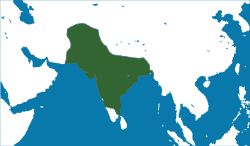
Bengal was absorbed within the Mughal Empire during the reign of Akbar after the Battle of Tukaroi (which was fought in 1575 near the village of Tukaroi, now in the Balasore District, West Bengal) between the Mughals and the Karrani Sultanate of Bengal and Bihar.[32] From that time Dhaka became the capital of the Mughal province of Bengal. But due to its geographical remoteness the Mughals found it difficult to govern the region. In particular, the area east of the Brahmaputra River remained outside mainstream Mughal influence. The Bengali ethnic and linguistic identity further crystallised during this period, since the whole of Bengal was united under an able and long-lasting administration. Furthermore, its inhabitants were given sufficient autonomy to develop their own customs and literature.
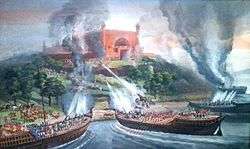
In 1612, during Emperor Jahangir's reign, the defeat of Sylhet completed the Mughal conquest of Bengal, except for Chittagong. During this time Dhaka rose in prominence by becoming the provincial capital of Bengal. Chittagong was later annexed in order to stop Arakanese raids from the east. A well-known Dhaka landmark, Lalbagh Fort, was built during Aurangzeb's reign.
Islam Khan
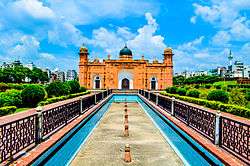
Islam Khan was appointed the Subahdar of Bengal in 1608 by Mughal emperor Jahangir. He ruled Bengal from his capital Dhaka which he renamed as Jahangir Nagar.[33] His major task was to subdue the rebellious Rajas, Bara-Bhuiyans, Zamindars and Afghan chiefs. He fought with Musa Khan, the leader of Bara-Bhuiyans, and by the end of 1611 Musa Khan was subdued.[33] Islam Khan also defeated Pratapaditya of Jessore, Ram Chandra of Bakla and Ananta Manikya of Bhulua.[33] Then he annexed the kingdoms of Koch Bihar, Koch Hajo and Kachhar, thus taking total control over entire Bengal other than Chittagong.[34]
Shaista Khan
Shaista Khan was appointed the Subahdar (Governor) of Bengal upon the death of Mir Jumla II in 1663.[35] He was the longest-serving governor of Bengal. He ably ruled the province from his administrative headquarters in Dhaka for almost 24 years from 1664 to 1688.[35] As governor, he encouraged trade with Europe, South-East Asia and other parts of India. He consolidated his power by signing trade agreements with European powers. Despite his powerful position he remained loyal to emperor Aurangzeb.[34]
Shaista Khan's great fame in Bengal chiefly rests on his re-conquest of Chittagong. Though Chittagong came under the suzerainty of Bengal during Sultan Fakhruddin Mubarak Shah's reign in 1342 and the Bengal Sultanate until the 16th century,[34] it subsequently went into the hands of Arakanese rulers in 1530. Considering the strategic importance of the Chittagong port, Shaista Khan gave the highest priority to recapturing it and was able to conquer Chittagong in January 1666.[35] The conquest brought a relief and peace to the people of Chittagong as pirates had caused a great distress to the local population.
The Nawabs of Bengal
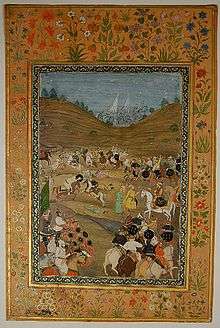
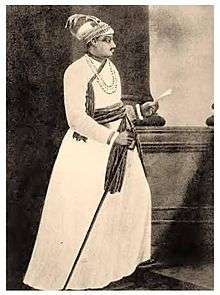
Murshid Quli Khan ended the nominal Mughal rule in 1717 when he declared Bengal's independence from the Mughal empire. He shifted the capital to Murshidabad ushering in a series of independent Bengal Nawabs.
The founder of the Nasiri, Murshid Quli Jafar Khan, was born a poor Deccani Oriya Brahmin before being sold into slavery and bought by one Haji Shafi Isfahani, a Persian merchant from Isfahan who converted him to Islam. He entered the service of the Emperor Aurangzeb and rose through the ranks before becoming Nazim of Bengal in 1717, a post he held until his death in 1727. He in turn was succeeded by his grandson and son-in-law until his grandson was killed in battle and succeeded by Alivardi Khan of the Afshar Dynasty in 1740.
The Afshar, ruled from 1740 to 1757. They were succeeded by the third and final dynasty to rule Bengal, the Najafi, when Siraj Ud Daula, the last of the Afshar rulers was killed at the Battle of Plassey in 1757.
Nawab Alivardi Khan showed military skill during his wars with the Marathas when they first invaded Bengal. He repulsed the first Maratha invasion from Bengal. He crushed an uprising of the Afghans in Bihar and made the British pay 150,000 Tk for blocking Mughal and Armenian trade ships. But the Marathas of the Maratha Empire invaded Bengal again and during the fourth Maratha invasion the Nawab Alivardi Khan was defeated and compelled to come to terms with the Marathas of the Maratha Empire.[36] He agreed to pay twelve lakhs of rupees annually as the chauth of Bengal, and ceded the province of Orissa to the Marathas.[36]
Colonial era
Europeans in Bengal
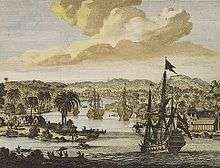
Portuguese traders and missionaries were the first Europeans to reach Bengal in the latter part of the 15th century. They established themselves in Chittagong and Hoogly. In 1632, the Mughal Subahdar of Bengal, Kasim Khan Mashadi, expelled the Portuguese after the Battle of Hooghly.
Dutch, French, and British East India Companies and representatives from Denmark soon followed in making contact with Bengal.
During Aurangzeb's reign, the local Nawab sold three villages, including one then known as Calcutta, to the British. Calcutta was Britain's first foothold in Bengal and remained a focal point of their economic activity. The British gradually extended their commercial contacts and administrative control beyond Calcutta to the rest of Bengal. Job Charnock was one of the first drivers of British influence in Bengal. He waged war against the Mughal authority of Bengal which led to the Anglo-Mughal war for Bengal (1686–1690). Shaista Khan, the Nawab of Bengal, defeated the British in the battles of Hooghly as well as Baleshwar and expelled the British from Bengal. Captain William Heath led a naval fleet against Chittagong but his efforts were unsuccessful and he had to retreat to Madras.
British rule

The British East India Company gained official control of Bengal following the Battle of Plassey in 1757. This was the first conquest, in a series of engagements that ultimately lead to the expulsion of other European competitors. The defeat of the Mughals and the consolidation of the subcontinent under the rule of a corporation was a unique event in imperialistic history. Kolkata (Anglicized as "Calcutta") on the Hooghly became a major trading port for bamboo, tea, sugar cane, spices, cotton, muslin and jute produced in Dhaka, Rajshahi, Khulna, and Kushtia.
Scandals and the bloody rebellion known as the Sepoy Mutiny prompted the British government to intervene in the affairs of the East India Company. In 1858, authority in India was transferred from the Company to the crown, and the rebellion was brutally suppressed. Rule of India was organized under a Viceroy and continued a pattern of economic exploitation. Famine racked the subcontinent many times, including at least two major famines in Bengal. The British Raj was politically organized into seventeen provinces of which Bengal was one of the most significant.
Bengal Renaissance
|
|
The Bengal Renaissance refers to a social reform movement during the 19th and early 20th centuries in Bengal during the period of British rule. The Bengal Renaissance can be said to have started with Raja Ram Mohan Roy (1775–1833)[37] and ended with Rabindranath Tagore (1861–1941). Bengal in the 19th century was a unique blend of religious and social reformers, scholars, literary giants, journalists, patriotic orators and scientists, all merging to form the image of a renaissance, and marked the transition from the 'medieval' to the 'modern'.[38] Bangladeshi people are also very proud of their national poet Kazi Nazrul Islam. He is greatly remembered for his active voice against the oppression of the British rulers in the 20th century. He was imprisoned for writing his most famous poem of "Bidrohee".
Partition of Bengal, 1905
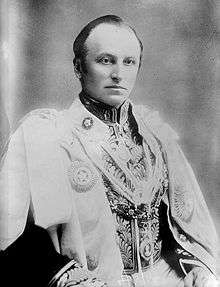
The decision to effect the Partition of Bengal (Bengali: বঙ্গভঙ্গ) was announced in July 1905 by the Viceroy of India, Lord Curzon. The partition took place on 16 October 1905 and separated the largely Muslim eastern areas from the largely Hindu western areas. The former province of Bengal was divided into two new provinces "Bengal" (comprising western Bengal as well as the province of Bihar and Orissa) and Eastern Bengal and Assam with Dacca as the capital of the latter.[39] Partition was promoted for administrative reasons: Bengal was geographically as large as France and had a significantly larger population. Curzon stated the eastern region was neglected and under-governed. By splitting the province, an improved administration could be established in the east, where subsequently, the population would benefit from new schools and employment opportunities. The Hindus of West Bengal who dominated Bengal's business and rural life complained that the division would make them a minority in a province that would incorporate the province of Bihar and Orissa.[40] Indians were outraged at what they recognised as a "divide and rule" policy,[41] where the colonisers turned the native population against itself in order to rule, even though Curzon stressed it would produce administrative efficiency. The partition was generally supported by the Muslims of East Bengal. Their support was motivated by both their poor economic conditions in East Bengal, and the perceived dominance of the Hindu businessmen and landlords in West Bengal over the governance of Bengal.
Due to political protests, the two parts of Bengal were reunited in 1911. A new partition which divided the province on linguistic, rather than religious grounds followed, with the Hindi, Oriya and Assamese areas separated to form separate administrative units: Bihar and Orissa Province was created to the west, and Assam Province to the east. The administrative capital of British India was moved from Calcutta to New Delhi as well.
Movement for self-rule and establishment of Pakistan
As the independence movement throughout British-controlled India began in the late 19th century gained momentum during the 20th century, Bengali politicians played an active role in Mohandas Gandhi's Congress Party and Mohammad Ali Jinnah's Muslim League, exposing the opposing forces of ethnic and religious nationalism. By exploiting the latter, the British probably intended to distract the independence movement, for example by partitioning Bengal in 1905 along religious lines. Partition of Bengal (1905) divided Bengal Presidency into an overwhelmingly Hindu west (including present-day Bihar and Odisha) and a predominantly Muslim east (including Assam).[42] Dhaka was made the capital of the new province of Eastern Bengal and Assam. But the split only lasted for seven years. The partition was abolished in 1911 due to severe opposition from Indian National Congress and a major section of the Bengali Hindus.[43]
Creation of Pakistan

The All-India Muslim League was founded on 30 December 1906, in the aftermath of partition of Bengal, on the sidelines of the annual All India Muhammadan Educational Conference in Shahbagh, Dhaka.[44] At first the Muslim League sought only to ensure minority Muslim rights in the future nation of independent India. However, in 1940 the Muslim League passed the Lahore Resolution which envisaged one or more Muslim majority states in South Asia. The resolution unambiguously rejected the concept of a United India because of increasing inter-religious violence[45] The resolution was moved in the general session by Sher-e-Bangla A. K. Fazlul Huq, the then Chief Minister of Bengal, and was adopted on 23 March 1940.[46] Non-negotiable was the inclusion of the Muslim parts of Punjab and Bengal in these proposed states. The stakes grew as a new Viceroy Lord Mountbatten of Burma was appointed expressly for the purpose of effecting a graceful British exit. Sectarian violence in Noakhali and Calcutta sparked a surge in support for the Muslim League, which won the majority seats in Bengal legislature in the 1946 election. This surge of support also emerged as a reaction against the British decision to reverse the 1905 Partition of Bengal, which the League regarded as a betrayal of the Bengali Muslims.[47] At the last moment Huseyn Shaheed Suhrawardy and Sarat Chandra Bose came up with the idea of an independent and unified Bengal state, which was endorsed by Jinnah. This idea was vetoed by the Indian National Congress.
British India was partitioned and the independent states of India and Pakistan were created in 1947; the region of Bengal was divided along religious lines. The predominantly Muslim eastern part of Bengal became the East Bengal (later renamed East Pakistan) province of Pakistan and the predominantly Hindu western part became the Indian state of West Bengal. Most of the Sylhet District of Assam also joined East Pakistan following a referendum .[48]
Pakistan's history from 1947 to 1971 was marked by political instability and economic difficulties. In 1956 a constitution was at last adopted, making the country an "Islamic republic within the Commonwealth". The nascent democratic institutions foundered in the face of military intervention in 1958, and the government imposed martial law between 1958 and 1962, and again between 1969 and 1971.
Almost from the advent of independent Pakistan in 1947, frictions developed between East and West Pakistan, which were separated by more than 1,000 miles of Indian territory. East Pakistanis felt exploited by the West Pakistan-dominated central government. Linguistic, cultural, and ethnic differences also contributed to the estrangement of East from West Pakistan.
The Bengali Language Movement
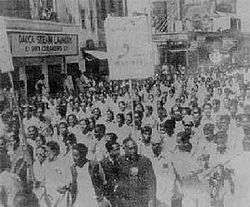
The Bengali Language Movement, also known as the Language Movement Bhasha Andolon, was a political effort in Bangladesh (then known as East Pakistan), advocating the recognition of the Bengali language as an official language of Pakistan. Such recognition would allow Bengali to be used in government affairs. Movement was led by Mufti Nadimul Quamar Ahmed. When the state of Pakistan was formed in 1947, its two regions, East Pakistan (also called East Bengal) and West Pakistan, were split along cultural, geographical, and linguistic lines. On 23 February 1948, the Government of Pakistan ordained Urdu as the sole national language, sparking extensive protests among the Bengali-speaking majority of East Pakistan. Facing rising sectarian tensions and mass discontent with the new law, the government outlawed public meetings and rallies. The students of the University of Dhaka and other political activists defied the law and organised a protest on 21 February 1952. The movement reached its climax when police killed student demonstrators on that day. The deaths provoked widespread civil unrest led by the Awami Muslim League, later renamed the Awami League. After years of conflict, the central government relented and granted official status to the Bengali language in 1956. On 17 November 1999, UNESCO declared 21 February International Mother Language Day for the whole world to celebrate,[49] in tribute to the Language Movement and the ethno-linguistic rights of people around the world.
Politics: 1954–1970

Great differences began developing between the two wings of Pakistan. While the west had a minority share of Pakistan's total population, it had the largest share of revenue allocation, industrial development, agricultural reforms and civil development projects. Pakistan's military and civil services were dominated by the Punjabis. Only one regiment in the Pakistani Army was Bengali. Many Bengali Pakistanis did not share the natural enthusiasm for the Kashmir issue, which they felt was leaving East Pakistan more vulnerable and threatened as a result.
In 1966, Sheikh Mujibur Rahman, the leader of the Awami League proclaimed a 6-point plan titled Our Charter of Survival at a national conference of opposition political parties at Lahore, in which he demanded self-government and considerable political, economic and defence autonomy for East Pakistan in a Pakistani federation with a weak central government. This led to the historic Six point movement.
In early 1968, the Agartala Conspiracy Case was filed against Sheikh Mujib and 34 others, with the allegation that the accused were planning to liberate the East Pakistan. However, as the trial progressed, a mass uprising formed in protest against this accusation and demanded the freeing of all the prisoners. On 15 February 1969, one of the prisoners, Zahurul Haq, was shot dead at point blank range, which further enraged the public leading the government to decide to withdraw the case on 22 February. The mass uprising subsequently culminated in the Uprising of '69.
On 25 March 1969, General Ayub Khan handed the state power to General Yahya Khan. Subsequently, all sorts of political activities in the country were postponed by the new military President. Nevertheless, some students kept the movement going clandestinely. A new group called 'February 15 Bahini' was formed under the leadership of Serajul Alam Khan and Kazi Aref Ahmed, who were members of the 'Swadhin Bangla Nucleus'.
Later in 1969, Yahya Khan announced a fresh election date for 5 October 1970.
Independence movement

After the Awami League won all the East Pakistan seats as well as a majority of the Pakistan's National Assembly in the 1970-71 elections, West Pakistan opened talks with the East on constitutional questions about the division of power between the central government and the provinces, as well as the formation of a national government headed by the Awami League.
The talks proved unsuccessful, however, and on 1 March 1971, Pakistani President Yahya Khan indefinitely postponed the pending National Assembly session, precipitating massive civil disobedience in East Pakistan.
On 2 March 1971, a group of students, led by A S M Abdur Rob, a student leader, raised the new (proposed) flag of Bangladesh under the direction of the Swadhin Bangla Nucleus. They demanded that Sheikh Mujibur Rahman declare the independence of Bangladesh immediately but Mujibur Rahman refused to agree to this demand. Rather, he decided that he would declare his next steps at a public meeting to be held on 7 March.
On 3 March, student leader, Shahjahan Siraj, read the 'Sadhinotar Ishtehar' (Declaration of independence) at Paltan Maidan in front of Bangabandhu Sheikh Mujib at a public gathering under the direction of the Swadhin Bangla Nucleus.
On 7 March, there was a public gathering in Suhrawardy Udyan to hear updates on the ongoing movement from Bangabandhu Sheikh Mujib, the leader of the movement that time. Although he avoided directly referring to independence, as the talks were still underway, he warned his listeners to prepare for any imminent war. The speech is considered a key moment in the war of liberation, and is remembered for the phrase,
- "Ebarer Shongram Amader Muktir Shongram, Ebarer Shongram Shadhinotar Shongram...."
- "Our struggle this time is a struggle for our freedom, our struggle this time is a struggle for our independence...."
Formal Declaration of Independence

In the early hours of 26 March 1971, a military crackdown by the Pakistan army began. The Bangabandhu Sheikh Mujibur Rahman was arrested and the political leaders dispersed, mostly fleeing to neighbouring India where they organised a provisional government. Before being arrested by the Pakistani Army, Sheikh Mujibur Rahman passed a hand written note which contained the Bangladeshi Declaration of Independence. This note was widely circulated and transmitted by the then East Pakistan Rifles' wireless transmitter. The world press reports from late March 1971 also make sure that Bangladesh’s declaration of independence by Bangabandhu was widely reported throughout the world. Bengali Army officer Major Ziaur Rahman captured the Kalurghat Radio Station[50][51] in Chittagong and read the declaration of independence of Bangladesh during the evening hours on 27 March.[52]
This is Swadhin Bangla Betar Kendra. I, Major Ziaur Rahman, at the direction of Bangobondhu Mujibur Rahman, hereby declare that the Independent People's Republic of Bangladesh has been established. At his direction, I have taken command as the temporary Head of the Republic. In the name of Sheikh Mujibur Rahman, I call upon all Bengalees to rise against the attack by the West Pakistani Army. We shall fight to the last to free our motherland. Victory is, by the Grace of Allah, ours. Joy Bangla.[53]
The Provisional Government of the People's Republic of Bangladesh was formed on 10 April in Meherpur (later renamed as Mujibnagar, a town adjacent to the Indian border). Sheikh Mujibur Rahman was announced to be the Head of the State. Tajuddin Ahmed became the Prime Minister, Syed Nazrul Islam became the acting President and Khondaker Mostaq Ahmed the Foreign Minister. There the war plan was sketched out with Bangladesh armed forces established and named "Muktifoujo". Later these forces were named "Muktibahini" (freedom fighters). M. A. G. Osmani was appointed as the Chief of the Armed Forces.
For military purposes, Bangladesh was divided into 11 sectors under 11 sector commanders. In addition to these sectors, later in the war, three special forces were formed: Z Force, S Force and K Force. These three forces' names were derived from the initial letters of the commander's name. The training and most of the arms and ammunitions were arranged by the Meherpur government which was supported by India. As fighting grew between the Pakistan Army and the Bengali Mukti Bahini, an estimated ten million Bengalis, mainly Hindus, sought refuge in the Indian states of Assam, Tripura and West Bengal.
The crisis in East Pakistan produced new strains in Pakistan's troubled relations with India. The two nations had fought a war in 1965, mainly in the west, but the pressure of millions of refugees escaping into India in autumn 1971, as well as Pakistani aggression, reignited Indian hostilities with Pakistan. Indian sympathies lay with East Pakistan, and on 3 December 1971, India intervened on the side of the Bangladeshis which led to a short, but violent, two-week war known as the Indo-Pakistani War of 1971.
Pakistani capitulation and aftermath
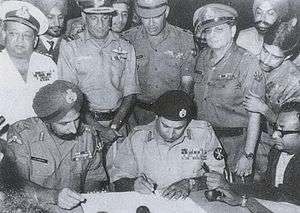
On 16 December 1971, Lt. Gen A. A. K. Niazi, CO of Pakistan Army forces located in East Pakistan signed the Instrument of Surrender and the nation of Bangla Desh ("Country of Bengal") was finally established the following day. At the time of surrender only a few countries had provided diplomatic recognition to the new nation. Over 90,000 Pakistani troops surrendered to the Indian forces making it the largest surrender since World War II.[54][55] The new country changed its name to Bangladesh on January 11, 1972 and became a parliamentary democracy under a constitution. Shortly thereafter on March 19 Bangladesh signed a friendship treaty with India. Bangladesh sought admission in the UN with most voting in its favour, but China vetoed this as Pakistan was its key ally.[56] The United States, also a key ally of Pakistan, was one of the last nations to accord Bangladesh recognition.[57] To ensure a smooth transition, in 1972 the Simla Agreement was signed between India and Pakistan. The treaty ensured that Pakistan recognised the independence of Bangladesh in exchange for the return of the Pakistani PoWs. India treated all the PoWs in strict accordance with the Geneva Convention, rule 1925.[58] It released more than 93,000 Pakistani PoWs in five months.[54]
Furthermore, as a gesture of goodwill, nearly 200 soldiers who were sought for war crimes by Bengalis were also pardoned by India. The accord also gave back more than 13,000 km2 (5,019 sq mi) of land that Indian troops had seized in West Pakistan during the war, though India retained a few strategic areas;[59] most notably Kargil (which would in turn again be the focal point for a war between the two nations in 1999).
People's Republic of Bangladesh
Constitution, early democracy and socialism
Provisional Government
The Provisional Government of Bangladesh was the country's first government. The Provisional Government was formed in Mujibnagar on 17 April 1971. It issued the proclamation of independence and drafted an interim constitution, declaring "Equality, Human Dignity and Social Justice" as its fundamental principles. Its prime minister was Tajuddin Ahmad and military chief of staff was M A G Osmani. Other important cabinet members included Syed Nazrul Islam and Muhammad Mansur Ali. It included the newly formed Bangladesh Civil Service with defecting members of the Civil Service of Pakistan. It also had a prominent diplomatic corps, led by Abu Sayeed Chowdhury, Humayun Rashid Choudhury and Rehman Sobhan among others. The Bangladesh Forces included eleven sector commanders, among whom prominent figures included Ziaur Rahman, Khaled Mosharraf and K M Shafiullah.[60][61]
Neighboring India provided diplomatic, economic and military support for the Provisional Government. The government's capital in exile was Calcutta. The Indian military intervened in the final two weeks of the war in December 1971 and ensured the surrender of Pakistan.
Sheikh Mujib administration
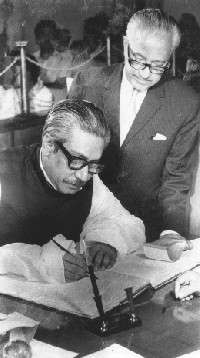
The left-wing Awami League, which had won the 1970 election in Pakistan, formed the first post-independence government in Bangladesh. Awami League leader Sheikh Mujibur Rahman became the 2nd Prime Minister of Bangladesh on 12 January 1972 and is widely regarded as the nation’s independence hero and founding father. Nation-building under his regime was based on secular Bengali nationalist principles. The original Constitution of Bangladesh, drafted by Dr. Kamal Hossain, laid down the structure of a liberal democratic parliamentary republic with socialist influences in 1972.
On the international stage, Rahman and his Indian counterpart Indira Gandhi signed the 25-year Indo-Bangladeshi Treaty of Friendship, Cooperation and Peace. Bangladesh joined the Organization of the Islamic Conference, the Commonwealth of Nations and the Non-Aligned Movement. Rahman was invited to Washington DC and Moscow for talks with American and Soviet leaders. In the Delhi Agreement of 1974, Bangladesh, India and Pakistan pledged to work for regional stability and peace. The agreement paved the way for the return of interned Bengali officials and their families stranded in Pakistan, as well as the establishing of diplomatic relations between Dhaka and Islamabad. Japan became a major aid provider to the new country. Although Israel was one of early countries to recognize Bangladesh,[62] the government in Dhaka strongly supported Egypt during the Arab-Israeli War of 1973. In return, Egypt gifted Bangladesh’s military with 44 tanks.[63] Many Eastern European countries, particularly Yugoslavia, East Germany and Poland, enjoyed excellent relations with Bangladesh.[64] The Soviet Union supplied several squadrons of Mig-21 planes for the Bangladesh Air Force.[65]
Domestically, Rahman’s regime became increasingly authoritarian. There was an insurgency by the radical socialist Jashod, as well as agitation by pro-business and conservative forces, who felt the Awami League was unfairly taking exclusive credit for the liberation struggle. Rahman imposed a three-month state of emergency in 1974 to quell protests. He formed the Jatiya Rakkhi Bahini, which was accused of human rights abuses. The Jatiya Rakkhi Bahini was also distrusted by many in the Bangladesh Army.[64]
Economically, Rahman embarked on a huge nationalization program. The economy suffered as a result of socialist planning. Soviet and Indian aid also failed to materialize in the desired quantity. The Bangladesh famine of 1974 was a major economic and food crisis. The government blamed the United States for having a role in causing the famine, due to American restrictions on food shipments to Bangladesh for Dhaka’s policy of exporting jute to Cuba. The government eventually turned to the World Bank and IMF for assistance.[66]
In January 1975, Sheikh Mujib dissolved the parliamentary system, established a one party state and assumed the presidency with extraordinary powers. Various political parties were merged into a sole legal national party- the Bangladesh Krishak Sramik Awami League, popularly known by its acronym BAKSAL. Most Bangladeshi newspapers were banned, except for four nationalized dailies. Sheikh Mujib quickly lost the support of most social groups in Bangladesh. The veterans of the liberation war were angered by the suppression of civil rights and democracy. The economic failure of Sheikh Mujib’s socialist policies alienated the population. Some historians and commentators described him as "the most hated man in Bangladesh" by 1975.[66]
On 15 August 1975, a group a junior army rebels assassinated Sheikh Mujib and most of his family at his private residence in Dhaka.[64]
Military coups and presidential regimes
First martial law and Zia administration

The coup leaders installed Vice President Khondaker Mostaq Ahmad as Sheikh Mujib’s immediate successor. A staunch conservative, Ahmad promulgated martial law and jailed many prominent confidantes of Sheikh Mujib, including Bangladesh’s first Prime Minister Tajuddin Ahmad. The jailed leaders were executed on 3 November 1975. Ahmad reshuffled the leadership of the Bangladesh Armed Forces, paving the way for the country’s future military dictatorship.[64]
A counter-coup led by Brigadier General Khaled Mosharraf overthrew Ahmad from the presidency on 6 November 1975. The chief justice, Abu Sadat Mohammad Sayem, was installed as president. Mosharraf was killed by renegade socialist troops led by Abu Taher on 7 November 1975. The army chief, Lieutenant General Ziaur Rahman, emerged as the country’s most powerful figure in 1976. He served as deputy martial law administrator under President Sayem.[64]
Under the dramatically altered dispensation, Bangladesh feared an invasion from India backed by the Soviet Union, as the new government in Dhaka received recognition from Pakistan, Saudi Arabia and China. According to declassified U.S. records, Bangladesh received assurances from the United States of Western support for its sovereignty and territorial integrity. The dispute over the sharing the water of the Ganges, due to India’s construction of the Farakka Barrage, led Bangladesh to seek the intervention of the United Nations in 1976. The dispute was addressed through a bilateral agreement in 1977.[64][67][68][68]
Lt Gen Ziaur Rahman (popular known as Zia) assumed the presidency and the office of CMLA from Justice Sayem on 21 April 1977. Following presidential elections in June 1978, Zia sought to give his presidency and political ambition democratic legitimacy. He formed the Bangladesh Nationalist Party (BNP) as a centre-right political party. Zia promoted the notion of Bangladeshi nationalism as a territorial and inclusive national identity, with an emphasis of the country’s Muslim heritage. Parliamentary elections were held in 1979, in which the BNP gained a landslide majority and the Awami League became the principal opposition party. Zia appointed the former East Pakistani politician and diplomat Shah Azizur Rahman as his prime minister. He also lifted the ban on the Jamaat-e-Islami.[69]
President Zia restored free markets, redefined socialism as “economic and social justice” in the constitution and crafted a foreign policy which emphasized solidarity with Muslim majority countries and regional cooperation in South Asia. Bangladesh achieved rapid economic and industrial growth under Zia’s presidency. The government built the country’s first export processing zones. It operated a popular food-for-work program, reversed the collectivization of farms and promoted private sector development.
Bangladesh's growing anti-communist profile saw President Zia strongly opposing the Soviet invasion of Afghanistan.
Zia faced twenty one attempted coups against his government, including one by the air force.[64] His one time ally Colonel Abu Taher was tried for treason and executed. Similar fates were met by many of his perceived rivals in the armed forces. However, the final coup attempt resulted in his assassination in 1981. Zia was killed by troops loyal to Major General Abul Manzoor who stormed his official residence in Chittagong on 30 May 1981. The mutiny was later suppressed by army chief Lieutenant General Hussain Muhammad Ershad.[64]
Sattar administration
Zia was succeeded by Vice President Abdus Sattar. President Sattar received a popular mandate during the 1981 presidential election, despite allegations of vote rigging by his rival Kamal Hossain. Sattar’s presidency was marked by infighting within the ruling BNP, which forced cabinet reshuffles and the resignation of Vice President Mirza Nurul Huda. A national security council was formed amid anti-Bengali Muslim violence in Northeast India and Burma.[68] Sattar also suffered from health problems due to old age.
The 1982 Bangladesh coup d'état deposed President Sattar and his civilian government.[68] The Bangladesh military cited food shortages, corruption and economic mismanagement as reasons behind the coup.
Second martial law and Ershad administration

.jpg)
Sattar was replaced by the chief justice A. F. M. Ahsanuddin Chowdhury. Lieutenant General Hussain Muhammad Ershad proclaimed martial law and became the Chief Martial Law Administrator. He appointed himself as the President of the Council of Ministers and the naval and air force chiefs as deputy martial law administrators. Ershad geared Bangladesh’s foreign policy more towards the anti-Soviet bloc.
In 1983, Ershad assumed the presidency. Political repression was rife under Ershad’s martial law regime. However, the government implemented a series of administrative reforms, particularly in terms of devolution. The eighteen districts of the country were divided into sixty four districts. The upazila system was also created.
Among his major actions were to privatize the largely state-owned economy (up to 70% of industry was in public ownership) and encourage private investment in heavy industries along with light manufacturing, raw materials, and newspapers. Foreign companies were invited to invest in Bangladeshi industry as well, and stiff protectionist measures were put in place to safeguard manufacturing. All political parties and trade unions were banned for the time being, with the death penalty to be administered for corruption and political agitation. Ershad's takeover was generally viewed as a positive development, as Bangladesh was in a state of serious economic difficulty. The country was facing significant food shortages. The government also faced a severe budget deficit to the tune of 4 billion takas, and the IMF declared that it would not provide any more loans until Bangladesh paid down some of its existing debts. During most of 1984, Ershad sought the opposition parties' participation in local elections under martial law. The opposition's refusal to participate, however, forced Ershad to abandon these plans. Ershad sought public support for his regime in a national referendum on his leadership in March 1985. He won overwhelmingly, although turnout was small. Two months later, Ershad held elections for local council chairmen. Pro-government candidates won a majority of the posts, setting in motion the President's ambitious decentralization program. Political life was further liberalized in early 1986, and additional political rights, including the right to hold large public rallies, were restored. At the same time, the Jatiya (National) Party, designed as Ershad's political vehicle for the transition from martial law, was established.[70] Despite a boycott by the BNP, led by President Zia's widow, Begum Khaleda Zia, parliamentary elections were held on schedule in May 1986. The Jatiya Party won a modest majority of the 300 elected seats in the National Assembly. The participation of the Awami League—led by the late President Mujib's daughter, Sheikh Hasina Wajed—lent the elections some credibility, despite widespread charges of voting irregularities.[70]
Ershad resigned as Chief of Army Staff and retired from military service in preparation for the presidential elections, scheduled for October. Protesting that martial law was still in effect, both the BNP and the AL refused to put up opposing candidates. Ershad easily outdistanced the remaining candidates, taking 84% of the vote. Although Ershad's government claimed a turnout of more than 50%, opposition leaders, and much of the foreign press, estimated a far lower percentage and alleged voting irregularities.
Ershad continued his stated commitment to lift martial law. In November 1986, his government mustered the necessary two-thirds majority in the National Assembly to amend the constitution and confirm the previous actions of the martial law regime. The President then lifted martial law, and the opposition parties took their elected seats in the National Assembly.[70] In July 1987, however, after the government hastily pushed through a controversial legislative bill to include military representation on local administrative councils, the opposition walked out of Parliament. Passage of the bill helped spark an opposition movement that quickly gathered momentum, uniting Bangladesh's opposition parties for the first time. The government began to arrest scores of opposition activists under the country's Special Powers Act of 1974. Despite these arrests, opposition parties continued to organize protest marches and nationwide strikes. After declaring a state of emergency, Ershad dissolved Parliament and scheduled fresh elections for March 1988.[70]
All major opposition parties refused government overtures to participate in these polls, maintaining that the government was incapable of holding free and fair elections. Despite the opposition boycott, the government proceeded. The ruling Jatiya Party won 251 of the 300 seats. The Parliament, while still regarded by the opposition as an illegitimate body, held its sessions as scheduled, and passed numerous bills, including, in June 1988, a controversial constitutional amendment making Islam Bangladesh's state religion and provision for setting up High Court benches in major cities outside of Dhaka. While Islam remains the state religion, the provision for decentralizing the High Court division has been struck down by the Supreme Court.[70]
By 1989, the domestic political situation in the country seemed to have quieted. The local council elections were generally considered by international observers to have been less violent and more free and fair than previous elections. However, opposition to Ershad's rule began to regain momentum, escalating by the end of 1990 in frequent general strikes, increased campus protests, public rallies, and a general disintegration of law and order.[70]
First caretaker government (1990-1991)
Ershad resigned under the pressure from the military and international community, as the pro-democracy movement spearheaded by Khaleda Zia and Sheikh Hasina engulfed the entire country and drew the participation of the middle and upper classes.
The chief justice, Shahabuddin Ahmed, was sworn in as acting president and formed the first caretaker government of Bangladesh. Ahmed placed Ershad under arrest and organized free and fair elections in 1991.
Return of parliamentary republic and Battle of the Begums
Khaleda administration (1991-1996)
The center-right BNP won a plurality of seats and formed a government with support from the Islamic party Jamaat-I-Islami, with Khaleda Zia, widow of Ziaur Rahman, obtaining the post of prime minister. Only four parties had more than 10 members elected to the 1991 Parliament: The BNP, led by Prime Minister Begum Khaleda Zia; the AL, led by Sheikh Hasina; the Jamaat-I-Islami (JI), led by Ghulam Azam; and the Jatiya Party (JP), led by acting chairman Mizanur Rahman Choudhury while its founder, former President Ershad, served out a prison sentence on corruption charges. Khaleda Zia became the first female prime minister in Bangladeshi history. The electorate approved still more changes to the constitution, formally re-creating a parliamentary system and returning governing power to the office of the prime minister, as in Bangladesh's original 1972 constitution. In October 1991, members of Parliament elected a new head of state, President Abdur Rahman Biswas.
Finance Minister Saifur Rahman launched a series of liberal economic reforms, which set a precedent in South Asia and was seen as a model in India, Pakistan and Sri Lanka.[71]
In March 1994, controversy over a parliamentary by-election, which the opposition claimed the government had rigged, led to an indefinite boycott of Parliament by the entire opposition. The opposition also began a program of repeated general strikes to press its demand that Khaleda Zia's government resign and a caretaker government supervise a general election. Efforts to mediate the dispute, under the auspices of the Commonwealth Secretariat, failed. After another attempt at a negotiated settlement failed narrowly in late December 1994, the opposition resigned en masse from Parliament. The opposition then continued a campaign of marches, demonstrations, and strikes in an effort to force the government to resign. The opposition, including the Awami League's Sheikh Hasina, pledged to boycott national elections scheduled for February 15, 1996.[19]
In February, Khaleda Zia was re-elected by a landslide in voting boycotted and denounced as unfair by the three main opposition parties. In March 1996, following escalating political turmoil, the sitting Parliament enacted a constitutional amendment to allow a neutral caretaker government to assume power and conduct new parliamentary election.
Second caretaker government (1996)
The chief justice Muhammad Habibur Rahman became the 1st Chief Advisor of Bangladesh under the country’s constitutional caretaker government system. During this period, President Abdur Rahman Biswas sacked army chief Lieutenant General Abu Saleh Mohammad Nasim for alleged political activities, causing the general mount an abortive coup. The sacked army chief ordered troops in Bogra, Mymensingh and Jessore to march towards Dhaka. However, the military commander of Savar sided with the president and deployed tanks in the capital and its surrounding highways, and also suspended ferry services, as part of operations to deter the coup forces. Lt Gen Nasim was later arrested in Dhaka Cantonment.
The Chief Advisor successfully held free and fair elections on 12 June 1996. The Awami League emerged as the single largest party, with 146 seats in parliament, followed by the BNP with 116 seats and Jatiya Party with 32 seats.
Hasina administration (1996-2001)
Sheikh Hasina formed what she called a "Government of National Consensus" in June 1996, which included one minister from the Jatiya Party and another from the Jatiyo Samajtantric Dal, a very small leftist party. The Jatiya Party never entered into a formal coalition arrangement, and party president H.M. Ershad withdrew his support from the government in September 1997. Only three parties had more than 10 members elected to the 1996 Parliament: the Awami League, BNP, and Jatiya Party. Jatiya Party president, Ershad, was released from prison on bail in January 1997.[70] International and domestic election observers found the June 1996 election free and fair, and ultimately, the BNP party decided to join the new Parliament. The BNP soon charged that police and Awami League activists were engaged in large-scale harassment and jailing of opposition activists. At the end of 1996, the BNP staged a parliamentary walkout over this and other grievances but returned in January 1997 under a four-point agreement with the ruling party. The BNP asserted that this agreement was never implemented and later staged another walkout in August 1997. The BNP returned to Parliament under another agreement in March 1998.[70]
The first Hasina administration is credited for landmark initiatives in environmental and inter-ethnic peacemaking. It was responsible for signing the Ganges Water Sharing Treaty with India and the Chittagong Hill Tracts Peace Accord with ethnic insurgents, for which Hasina won the UNESCO Peace Prize. Hasina was also one of the founding leaders of the Developing 8 Countries. In 1998, Hasina hosted a rare and unprecedented trilateral economic summit in Dhaka with Prime Ministers Nawaz Sharif of Pakistan and I. K. Gujral of India. Her summits with U.S. President Bill Clinton in Dhaka and Washington DC focused on American energy investments for Bangladesh's natural gas reserves and the extradition of her father's killers. However, Hasina was not keen to allow the export of Bangladeshi natural gas, despite demands from multinational firms.[72][73][74][75][76]
In June 1999, the BNP and other opposition parties again began to abstain from attending Parliament. Opposition parties staged an increasing number of nationwide general strikes, rising from six days of general strikes in 1997 to 27 days in 1999. A four-party opposition alliance formed at the beginning of 1999 announced that it would boycott parliamentary by-elections and local government elections unless the government took steps demanded by the opposition to ensure electoral fairness. The government did not take these steps, and the opposition subsequently boycotted all elections, including municipal council elections in February 1999, several parliamentary by-elections, and the Chittagong city corporation elections in January 2000.[70]
In July 2001, the Awami League government stepped down to allow a caretaker government to preside over parliamentary elections. Political violence that had increased during the Awami League government's tenure continued to increase through the summer in the run up to the election. In August, Khaleda Zia and Sheikh Hasina agreed during a visit of former President Jimmy Carter to respect the results of the election, join Parliament win or lose, forswear the use of hartals (violently enforced strikes) as political tools, and if successful in forming a government allow for a more meaningful role for the opposition in Parliament.
Third caretaker government (2001)
The caretaker government, led by Chief Advisor Latifur Rahman, was successful in containing the violence, which allowed a parliamentary general election to be successfully held on October 1, 2001. The election saw a landslide victory of the BNP-led coalition, which included the far-right Jamaat-e-Islami and Islami Oikya Jote. The BNP won 193 seats and the Jamaat won 17 seats.[70]
Khaleda administration (2001-2006)

Following the September 11 attacks, the government of Prime Minister Khaleda Zia allowed the United States to use Bangladeshi airports and airspace for combat operations in Afghanistan. Bangladesh was also quick to respond to relief efforts in Afghanistan after the overthrow of the Taliban, with BRAC becoming the largest development agency in the war-torn country. The United States praised Bangladesh as an “elegant, compelling and greatly needed voice of moderation” in the Muslim world.[77] Khaleda Zia also developed a strategic partnership with China and signed a Defense Cooperation Agreement with Beijing.[78]
Despite her August 2001 pledge and all election monitoring groups declaring the election free and fair, Sheikh Hasina condemned the last election, rejected the results, and boycotted Parliament. In 2002, however, she led her party legislators back to Parliament, but the Awami League again walked out in June 2003 to protest derogatory remarks about Hasina by a State Minister and the allegedly partisan role of the Parliamentary Speaker. In June 2004, the AL returned to Parliament without having any of their demands met. They then attended Parliament irregularly before announcing a boycott of the entire June 2005 budget session.
Khaleda Zia’s administration was marked by improved economic growth, corruption allegations and growing rifts between the country’s secular and conservative forces. Her son Tarique Rahman was described in American diplomatic cables released by Wikileaks as being “notorious for flagrantly and frequently demanding bribes in connection with government procurement actions and appointments to political office”.[79] A series of high profile assassinations targeted the Awami League-led opposition. Former Prime Minister Sheikh Hasina narrowly escaped an assassination attempt in 2004. The Jamaatul Mujahadeen Bangladesh launched several terrorist attacks in 2005. The League accused the BNP and Jamaat of having complicity in the rise of militancy. Relations with neighboring India deteriorated over allegations that Bangladeshi territory was allowed to be used by Northeast Indian insurgents.
Fourth caretaker regime (2006-2008)
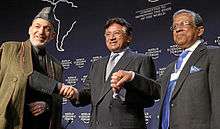
A major political crisis erupted after the end of the BNP’s tenure, as the Awami League-led coalition demanded a neutral candidate for Chief Advisor. Weeks of strikes, protests and blockades paralyzed the country. President Iajuddin Ahmed assumed the responsibilities of Chief Advisor but failed to allay the fears of the opposition of an impending rigged election. The Bangladeshi press accused the president of acting under the influence of the BNP. Violent protests continued even as the military was deployed in aid of civil administration.
On 11 January 2007, a state of emergency was declared by President Ahmed, who resigned from the office of chief advisor under widely reported pressure from the military, particularly the army chief General Moeen U Ahmed.[80] The former governor of the central bank, Dr. Fakhruddin Ahmed, was appointed as the Chief Advisor and the cabinet was reshuffled with many technocrats. The military-backed caretaker government started an anti-corruption drive, which saw the arrest of over 160 politicians, businessmen and bureaucrats, including former prime ministers Khaleda Zia and Sheikh Hasina, as well as Khaleda’s two sons. Student protests in Dhaka University demanded the restoration of democracy in August 2007, but were suppressed by a curfew. Khaleda and Hasina were released in 2008.
The state of emergency lasted for two years. The December 2008 election saw a landslide victory for the Awami League-led coalition, which also included the Jatiya Party.
Hasina administration (2009 - present)
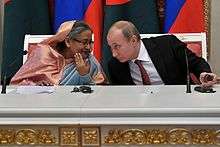
Within two months of assuming office, Sheikh Hasina’s second government faced the BDR Mutiny, which provoked tensions with sections of the military. Hasina successfully tackled the threat from mutineers and enraged elements in the military. She formed the international crimes tribunal to prosecute surviving Bengali Islamist collaborators of the 1971 genocide. The tribunal has criticism over its fairness and impartiality. Most of its convicted and executed war criminals are senior leaders of the Jamaat-e-Islami, a party accused of opposing Bangladesh’s independence and aiding Pakistan during the genocide.
An anti-terror crackdown dramatically improved relations with neighboring India. Bangladesh and India have increasingly focused on regional connectivity and trade.
In 2010, the Supreme Court of Bangladesh reaffirmed secularism as a fundamental principle in the constitution. The war crimes tribunal mobilized public opinion in favor of secularism, which was manifested in the March 2013 Shahbag protests. In response, a huge Islamist mobilization also took place led by the Hefazat-e-Islam group in May 2013.
The intense bickering between the League and BNP, often dubbed the Battle of the Begums, has continued. The Hasina government abolished the provision of caretaker government in the constitution through the controversial Fifteenth Amendment. The move was seen by the BNP as an attempt to corrupt the election process in favor of the League. Street violence between the League, BNP and the Jamaat intensified in the run up to the general election. In 2014, the general election was boycotted by the BNP; while the Jamaat was barred from contesting. It was also the most violent election in Bangladeshi history. The election was criticized by the United States as one sided. Sheikh Hasina was sworn in for a third tenure as prime minister.
In 2015 and 2016, Bangladesh has seen increasing assassinations targeting minorities and secularists, including Hindus, Buddhists, Christians, Western and Asian expatriates, LGBT activists, Sufi Muslims, bloggers, publishers and atheists. The country’s worst terrorist attack saw the death of 20 people after an upmarket restaurant was sieged by gunmen in July 2016. The Islamic State of Iraq and Levant has claimed responsibility for the many of the attacks, although the Hasina government insists local terror outfits are more likely to be responsible.
Chittagong Hill Tracts conflict
The Chittagong Hill Tracts is the southeastern mountainous frontier of Bangladesh with Burma and Northeast India. The area enjoyed autnomy under British Bengal. Its autonomous status was revoked by Pakistan, which built the controversial Kaptai Dam that displaced the area's indigenous people. When Bangladesh became independent, the government of Sheikh Mujibur Rahman adopted a Bengali nationalist constitution, which denied recognition of the country's ethnic minorities. Manabendra Narayan Larma, a member of parliament form the hill tracts, called for constitutional recognition of the indigenous people of the area. He gave a notable speech at the Constituent Assembly of Bangladesh demanding the use of "Bangladeshi" as the country's nationality definition, instead of Bengali. During the 1970s and 80s, there were attempts by the government to settle the with Bengali people. These attempts were resisted by the hill tribes, who, with the latent support of neighboring India, formed a guerrilla force called Shanti Bahini. As a result of the tribal resistance movement, successive governments turned the Hill Tracts into a militarized zone.
Following years of unrest, the Chittagong Hill Tracts Peace Accord was formed between the government of Bangladesh and the tribal leaders which granted a limited level of autonomy to the elected council of the three hill districts.
Political and religious terrorism
Bangladesh has faced terrorism from various left-wing and radical Islamic groups.
See also
- History of Asia
- History of Assam
- History of Bengal
- History of Bangladesh after independence
- History of India
- History of Pakistan
- History of South Asia
- List of Presidents of Bangladesh
- List of Prime Ministers of Bangladesh
- List of rulers of Bengal
- Politics of Bangladesh
- Timeline of Bangladeshi history
- Timeline of Dhaka
References
- ↑ Frank Jacobs (6 January 2013). "Peacocks at Sunset". Opinionator: Borderlines. The New York Times. Retrieved 2012-07-15.
- ↑ RIYAZU-S-SALĀTĪN: A History of Bengal, Ghulam Husain Salim, The Asiatic Society, Calcutta, 1902.
- ↑ Dynastic History of Magadha, Cir. 450-1200 A.D. by Bindeshwari Prasad Sinha p.181
- ↑ India: A History by John Keay p.220
- ↑ The Cambridge Shorter History of India p.145
- ↑ Ancient Indian History and Civilization by Sailendra Nath Sen p.281
- 1 2 Bangladesh (People'S Republic Of Bangladesh) Pax Gaea World Post Human Rights Report. Paxgaea.com. Retrieved on 2013-07-12.
- ↑ Shaffer, Jim. 1993, "Reurbanization: The eastern Punjab and beyond." In Urban Form and Meaning in South Asia: The Shaping of Cities from Prehistoric to Precolonial Times, ed. H. Spodek and D.M. Srinivasan.
- ↑ http://a.harappa.com/sites/g/files/g65461/f/CulturesSocietiesIndusTrad.pdf
- ↑ Millard Fuller. "(अंगिका) Language : The Voice of Anga Desh". Angika. Retrieved 2014-03-04.
- ↑ Singh, Upinder (2008). A History of Ancient and Early Medieval India: From the Stone Age to the 12th Century. Delhi: Pearson Education. pp. 260–4. ISBN 978-81-317-1120-0.
- ↑ Sengupta, Nitish K. (2011). Land of Two Rivers: A History of Bengal from the Mahabharata to Mujib. Penguin Books India. p. 40. ISBN 978-0-14-341678-4.
- ↑ Biplab Dasgupta (2005). European Trade and Colonial Conquest. Anthem Press. pp. 341–. ISBN 978-1-84331-029-7.
- 1 2 Sailendra Nath Sen (1999). Ancient Indian History and Civilization. New Age International. pp. 277–287. ISBN 978-81-224-1198-0.
- ↑ George E. Somers (1977). Dynastic History Of Magadha. Abhinav Publications. p. 185. ISBN 978-81-7017-059-4.
- 1 2 Sengupta, Nitish K. (2011). Land of Two Rivers: A History of Bengal from the Mahabharata to Mujib. New Delhi: Penguin Books India. p. 45. ISBN 978-0-14-341678-4.
- ↑ The Cambridge Shorter History of India p.10
- ↑ Encyclopaedia of North-East India by T. Raatan p.143
- ↑ Roy, Niharranjan (1993). Bangalir Itihas: Adiparba. Calcutta: Dey's Publishing. p. 408-9. ISBN 81-7079-270-3.
- ↑ Eaton, R (1996). The Rise of Islam and the Bengal Frontier. University of California Press. ISBN 0-520-20507-3.
- ↑ "District Website of Nadia". Government of West Bengal.Retrieved: 2014-02-12
- ↑ Sen, Amulyachandra (1954). Rajagriha and Nalanda. Institute of Indology, volume 4. Calcutta: Calcutta Institute of Indology, Indian Publicity Society. p. 52. OCLC 28533779.
- ↑ "History of Bangladesh". Lonely Planet.Retrieved: 2014-02-16
- ↑ "International Education Programmes and Qualifications from Cambridge". projects.cie.org.uk. Retrieved 2014-01-25.
- ↑ Ahmed, ABM Shamsuddin (2012). "Ilyas Shah". In Islam, Sirajul; Jamal, Ahmed A. Banglapedia: National Encyclopedia of Bangladesh (Second ed.). Asiatic Society of Bangladesh.
- ↑ Khan, Muazzam Hussain (2012). "Ibn Battuta". In Islam, Sirajul; Jamal, Ahmed A. Banglapedia: National Encyclopedia of Bangladesh (Second ed.). Asiatic Society of Bangladesh.
- 1 2 3 Khan, Muazzam Hussain (2012). "Fakhruddin Mubarak Shah". In Islam, Sirajul; Jamal, Ahmed A. Banglapedia: National Encyclopedia of Bangladesh (Second ed.). Asiatic Society of Bangladesh.
- ↑ "About Chittagong:History". Local Government Engineering Department, Government of Bangladesh.Retrieved: 2014-03-09
- ↑ "Historical Sites needs to be preserved". The Daily Star. 5 September 2009. Retrieved 2014-03-09.
- ↑ Ibn Batuta, Famous Bengalis and Related Topics, Retrieved: 2014-03-09
- ↑ Biographical encyclopedia of Sufis By N. Hanif, pg.320
- ↑ The History of India: The Hindú and Mahometan Periods By Mountstuart Elphinstone, Edward Byles Cowell, Published by J. Murray, Calcutta 1889, Public Domain
- 1 2 3 Karim, Abdul (2012). "Islam Khan Chisti". In Islam, Sirajul; Jamal, Ahmed A. Banglapedia: National Encyclopedia of Bangladesh (Second ed.). Asiatic Society of Bangladesh.
- 1 2 3 Sarkar, Jadunath (2003). The History of Bengal (Volume II): Muslim Period. Delhi: B.R. Publishing. ISBN 81-7646-239-X.
- 1 2 3 Karim, Abdul (2012). "Shaista Khan". In Islam, Sirajul; Jamal, Ahmed A. Banglapedia: National Encyclopedia of Bangladesh (Second ed.). Asiatic Society of Bangladesh.
- 1 2 Sirajuddaullah and the East India Company, 1756-1757: by Brijen Kishore Gupta p.23
- ↑ Sengupta, Nitish K. (2001). History of the Bengali-speaking People. UBS Publishers' Distributors. p. 211. ISBN 81-7476-355-4.
- ↑ Sumit Sarkar, "Calcutta and the Bengal Renaissance", in Calcutta, the Living City ed. Sukanta Chaudhuri, Vol I, p. 95.
- ↑ David Gilmour, Curzon: Imperial Statesman (1994) pp 271–3
- ↑ Encyclopedia Britannica, "the creation of the barrier" http://www.britannica.com/EBchecked/topic/60754/partition-of-Bengal
- ↑ Chandra, Bipan (2009). History of Modern India. New Delhi: Orient Blackswan. pp. 248–249. ISBN 978-81-250-3684-5.
- ↑ Encyclopædia Britannica, "Partition of Bengal" http://www.britannica.com/EBchecked/topic/60754/partition-of-Bengal
- ↑ Gordon Johnson, "Partition, Agitation and Congress: Bengal 1904 To 1908," Modern Asian Studies, (May 1973) pp 533–588
- ↑ Jalal, Ayesha (1985). The sole spokesman : Jinnah, the Muslim League, and the demand for Pakistan. Cambridge (UK); New York: Cambridge University Press. ISBN 978-0-521-24462-6.
- ↑ Malik, Muhammad Aslam (2001). The making of the Pakistan resolution. Karachi: Oxford University Press. ISBN 978-0-19-579538-7.
- ↑ Qutubuddin Aziz. "Muslim's struggle for independent statehood". Jang Group of Newspapers. Retrieved 2014-02-12.
- ↑ Kulke, Hermann; Dietmar Rothermund (1986). A History of India. Totowa, New Jersey: Barnes & Noble. pp. 300–312. ISBN 978-0-389-20670-5.
- ↑ "Sylhet (Assam) to join East Pakistan". Keesing's Record of World Events. July 1947. p. 8722.
- ↑ Glassie, Henry and Mahmud, Feroz.2008.Living Traditions. Cultural Survey of Bangladesh Series-II. Asiatic Society of Bangladesh. Dhaka. p.578
- ↑ Admin. (20 March 2011). "Major Ziaur Rahman's revolt with 8 East Bengal Regiment at Chittagong". Newsbd71.blogspot.com. Retrieved 2013-02-18.
- ↑ Ziaur Rahman's interview
- ↑ BDNEWS24.com
- ↑ Gupta, Jyota Sen (1974). History of Freedom Movement in Bangladesh, 1943-1973: Some Involvement (First ed.). Calcutta: Naya Prokash. p. 325-326.
- 1 2 "54 Indian PoWs of 1971 war still in Pakistan". DailyTimes. 19 January 2005. Retrieved 2011-10-11.
- ↑ "The 1971 war". BBC News. Retrieved 2011-10-11.
- ↑ Section 9. Situation in the Indian Subcontinent, 2. Bangladesh's international position – Ministry of Foreign Affairs of Japan
- ↑ who's coming to dinner Naeem Bangali
- ↑ "Bangladesh: Unfinished Justice for the crimes of 1971 – South Asia Citizens Web". Sacw.net. Retrieved 2011-06-23.
- ↑ "The Simla Agreement 1972 – Story of Pakistan". Storyofpakistan.com. 1 June 2003. Retrieved 2011-06-23.
- ↑ http://www.thedailystar.net/op-ed/genesis-bangladeshs-constitution-1209718
- ↑ http://en.banglapedia.org/index.php?title=Mujibnagar_Government
- ↑ Tepper, Elliot L.; Hayes, Glen A. (1990). Bengal and Bangladesh: Politics and Culture on the Golden Delta. Asian Studies Center, Michigan State University. p. 103.
- ↑ http://www.globalsecurity.org/military/world/bangladesh/army-modernization.htm
- 1 2 3 4 5 6 7 8 Mascarenhas, Anthony (1986) Bangladesh: A Legacy of Blood. Hodder and Stoughton
- ↑ http://www.globalsecurity.org/military/world/bangladesh/air-force-modernization.htm
- 1 2 Lewis, David (2011). Bangladesh: Politics, Economy and Civil Society. Cambridge University Press. ISBN 978-1-139-50257-3.
- ↑ http://www.indiandefencereview.com/why-bangladesh-feared-indian-invasion-after-1975-coup/
- 1 2 3 4 Preston, Ian, ed. (2003). A Political Chronology of Central, South and East Asia. Europa Publications. p. 18. ISBN 978-1-135-35680-4.
- ↑ Khasru, B.Z. The Bangladesh Military Coup and the CIA Link. Rupa Publications India Pvt. Ltd. ISBN 978-81-291-3416-5.
- 1 2 3 4 5 6 7 8 9 10 Bureau of South and Central Asian Affairs (March 2008). "Background Note: Bangladesh". U.S. Department of State. Archived from the original on 2008-06-11. Retrieved 2008-06-11. This article incorporates text from this source, which is in the public domain.
- ↑ http://www.dhakatribune.com/opinion/op-ed/2016/09/06/remembering-budget-wizard/
- ↑ Ken Conca; Geoffrey D. Dabelko (13 November 2002). Environmental Peacemaking. Woodrow Wilson Center Press. p. 69. ISBN 978-0-8018-7193-1.
- ↑ Rajkumari Chandra Kalindi Roy (2000). Land Rights of the Indigenous Peoples of the Chittagong Hill Tracts, Bangladesh. IWGIA. p. 164. ISBN 978-87-90730-29-1.
- ↑ Bangladesh Development Initiative (2007). Political culture in Bangladesh: perspectives and analysis : selections from the journal of Bangladesh studies. Bangladesh Development Initiative. p. 323. ISBN 978-984-05-1782-4.
- ↑ http://articles.latimes.com/2000/mar/21/news/mn-11124
- ↑ Kant Kishore Bhargava; Sridhar K. Khatri; Coalition for Actions for South Asian Cooperation (Kathmandu, Nepal) (1999). Working paper for Conference on South Asia 2010: Opportunities and Challenges, Kathmandu, December 1-3, 1999. Coalition for Action on South Asian Cooperation. p. 16.
- ↑ http://news.bbc.co.uk/2/hi/south_asia/3003010.stm
- ↑ http://www.southasiaanalysis.org/paper582
- ↑ https://wikileaks.org/plusd/cables/08DHAKA1143_a.html
- ↑ http://www.economist.com/node/8560006
Sources
- CIA World Factbook (July 2005). Bangladesh
- US Department of State (August 2005). "Background Note: Bangladesh"
- Ahmed, Helal Uddin (2012). "History". In Islam, Sirajul; Jamal, Ahmed A. Banglapedia: National Encyclopedia of Bangladesh (Second ed.). Asiatic Society of Bangladesh.
- Library of Congress (1988). A Country Study: Bangladesh
- Bonazzi, Eros (2011). La Storia del Bengala e del Bangladesh (in Italian). Azeta Fastpress. ISBN 978-88-89982-30-3.
- "Declaration of Independence of Bangladesh Original Speech by Ziaur Rahman". scribd.com. Retrieved 2014-01-25.
Further reading
- Hussain, Aklam. History of Bangladesh, 1704-1971 (Vol. 1. Asiatic Society of Bangladesh, 1997).
- Raghavan, Srinath. 1971: A Global History of the Creation of Bangladesh (Harvard University Press; 2014) 258 pages; scholarly history with worldwide perspective.
- Van Schendel, Willem. A history of Bangladesh (Cambridge University Press, 2009).
External links
- Rulers.org — Bangladesh List of rulers for Bangladesh
- Bangladesh Newspapers & Magazine Directory
- Bangla Newspapers & Magazine Directory
- Bangla Newspapers & Magazine Directory
